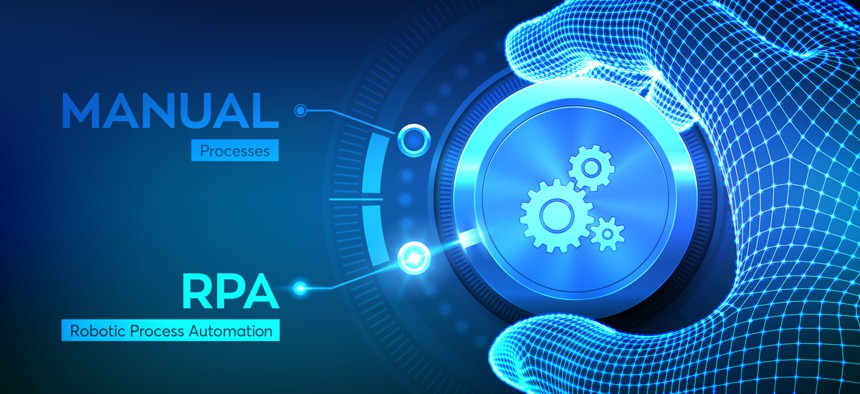When Automation Sets Government Agencies Up for Failure

Iurii Motov/Shutterstock.com
It's important to take the time to design a better system and workflow.
State government chief information officers said technology debt in their legacy systems was a major source of their organization’s inability to be responsive to change, migrate to new technologies, add new functionality to their systems and innovate, according to a recent report by NASCIO.
Unfortunately, this is the fate for many government organizations and one major contributor to the mounting technical debt is when automation is simply applied to legacy technology and existing manual processes rather than taking the time to design a better system and workflow.
And this rarely sets organizations up for success, especially over the long term. In fact, teams will often find themselves in a continuous loop of refactoring the functionality because they’re not achieving the desired outcomes.
Moving Toward Optimization
It’s been said that all businesses are becoming technology companies, and that applies to the public sector as well. Government agencies are now expected to keep pace with the private sector and the ever-evolving needs and expectations of their stakeholders and constituents. To do that, agencies are turning to digital platforms to enable more seamless experiences—internal and external-facing experiences.
But today, much of the IT team’s focus continues to remain on keeping the lights on rather than investing in the tools and innovation that will seed long-term returns. Often this means, they’re pressured to prioritize quick delivery over well-thought-out workflows. And this is fine if the goal is simply to automate the current state and realize nominal gains on labor expenditures.
But most organizations want to achieve far more than the basic labor cost savings automation can deliver. And this requires understanding existing processes and workflows and mapping those to the desired state.
Automating New Ways of Performing and Delivering
All too often, automation implementations support the “as-is” state—applying otherwise powerful functionality to existing workflows that have already proven to be inefficient and ineffective. Most organizations fail to examine and document the steps in their current workflows, and when they do, they miss opportunities to significantly improve process outcomes, cycle times, quality, and costs.
Combining process redesign with automation will have a major impact on the return on investment—far greater than if automation were implemented with no change to the process. The path to realizing improved outcomes requires involving stakeholders, documenting to discover inefficiencies, and establishing benchmarks.
Developing a People-First Agenda
People, not tech, are keystone to process improvement. Getting stakeholders—customers, employees, and leadership—involved will help uncover friction points in workflows and the overall experience. Where do they spend excess time? What frustrates them about the current experience? What do they think is working well?
Gaining input to those going through the agency’s processes and workflows is mission-critical, but it’s often overlooked. In fact, according to a recent report by NASCIO, employees are only involved in innovation initiatives 40% of the time and citizens only 3% of the time. Yet, senior leaders are engaged in nearly 50% of these initiatives.
Documenting to Reveal Deficiencies and Inefficiencies
Working with internal stakeholders to document their current process workflows will help expose deficiencies and inefficiencies. There can be some trepidation around this, however. It’s imperative to create an environment where they feel secure enough to share honest insights without fear of retribution.
The goal is to drill down to every individual step and procedure and determine what to keep, update or eliminate. Often processes can be consolidated or removed. But documenting these procedures has benefits beyond just preparing for automation—it also helps to get leadership and all team members on the same page operationally, which is important for gaining adoption of the new automation and achieving agencywide efficiency.
Also review regulations and statutes to see how changes and updates might impact workflows and processes. For instance, in the licensing sector, state and local statutes are constantly changing, often requiring applicant forms to be updated. In many cases, they can be shortened and certain requirements like wet signatures and in-person notary or ID verifications eliminated. This is important to consider before applying automation to otherwise lengthy and unnecessary processes.
Documenting processes now can also serve as a foundation for training manuals down the road as well.
Mapping Benchmarks that Matter
Failing to establish any baseline metrics before implementing automation technology—like the time it takes to process a request or handle a complaint—agencies have no way to gauge what improved and to what degree.
Taking the time to identify the metrics that matter will also reveal pain points and areas in need of process improvement. For instance, looking at complaint resolution from the customer’s standpoint and tracking the number of “touch times” per resolution, could unveil steps that could be eliminated to alleviate the number of touchpoints and create a better customer experience.
Finally, consider the technology. When the goal is greater agility and efficiency, the right solution will help enable the digitization and innovation over the long term. If the technology is extremely niche and obscure, make sure updates are maintained and there’s enough of a support team to help when challenges arise. This is also an opportunity to move away from legacy technology debt and towards replatforming in the cloud with a global, hyperscale solution.
Yes, automation can deliver savings and improvements without diving into process and workflow details. But automation-enabled process transformation will raise performance to new heights and enable agencies to be more responsive to change—yielding benefits far beyond that which simple task automation promises.
Brian Kirby is the director of strategic licensing solutions at MST Solutions.
NEXT STORY: How to Work from Home Without Hurting Your Back





